Capital Punishment: Its Historical Development
VerifiedAdded on 2023/06/09
|6
|1666
|469
AI Summary
This paper discusses capital punishment as a form of punishment in modern day, its historical development, public opinion about it, death penalty for juveniles, movement for painless execution and controversies pertaining to it.
Contribute Materials
Your contribution can guide someone’s learning journey. Share your
documents today.
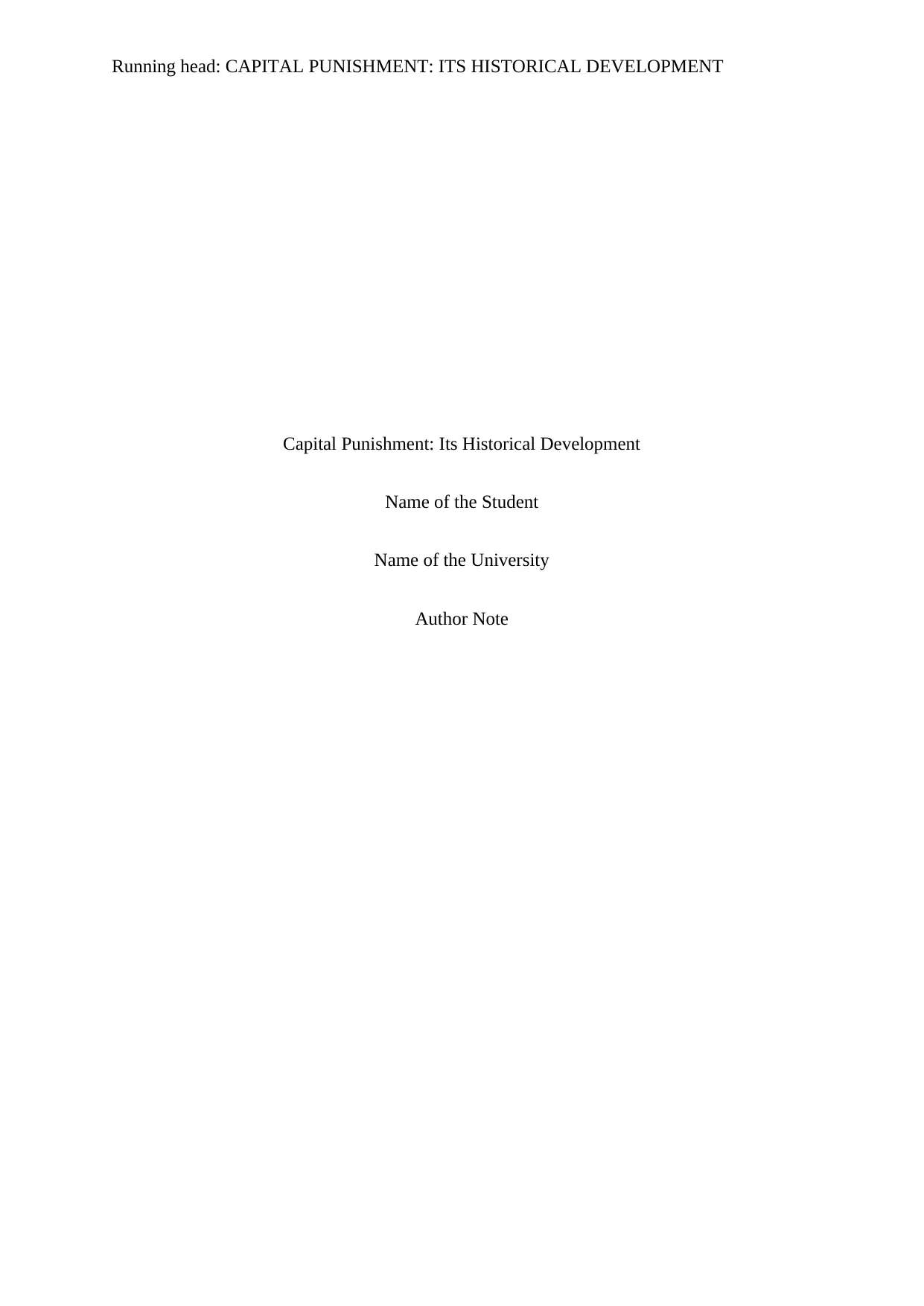
Running head: CAPITAL PUNISHMENT: ITS HISTORICAL DEVELOPMENT
Capital Punishment: Its Historical Development
Name of the Student
Name of the University
Author Note
Capital Punishment: Its Historical Development
Name of the Student
Name of the University
Author Note
Secure Best Marks with AI Grader
Need help grading? Try our AI Grader for instant feedback on your assignments.
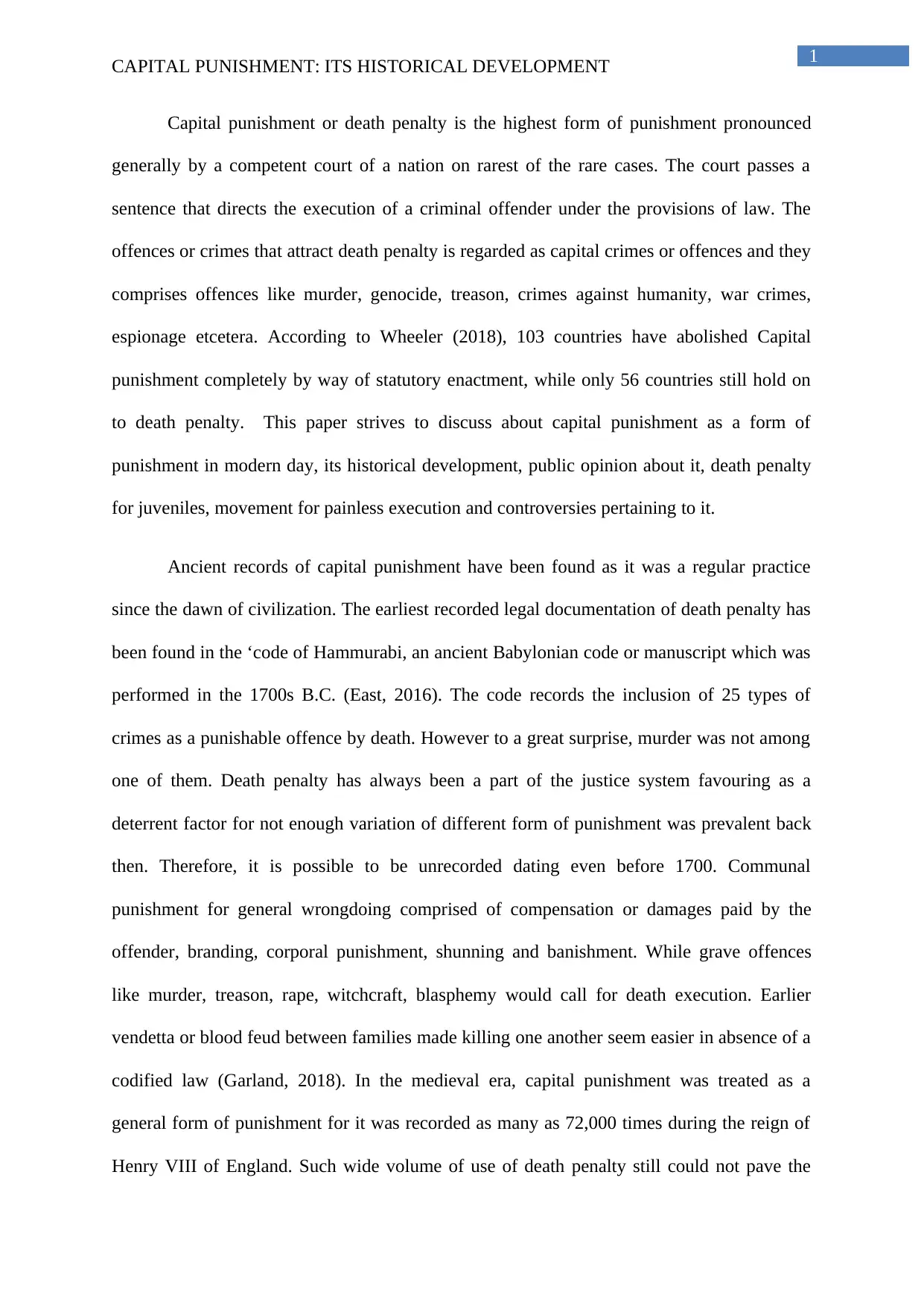
1
CAPITAL PUNISHMENT: ITS HISTORICAL DEVELOPMENT
Capital punishment or death penalty is the highest form of punishment pronounced
generally by a competent court of a nation on rarest of the rare cases. The court passes a
sentence that directs the execution of a criminal offender under the provisions of law. The
offences or crimes that attract death penalty is regarded as capital crimes or offences and they
comprises offences like murder, genocide, treason, crimes against humanity, war crimes,
espionage etcetera. According to Wheeler (2018), 103 countries have abolished Capital
punishment completely by way of statutory enactment, while only 56 countries still hold on
to death penalty. This paper strives to discuss about capital punishment as a form of
punishment in modern day, its historical development, public opinion about it, death penalty
for juveniles, movement for painless execution and controversies pertaining to it.
Ancient records of capital punishment have been found as it was a regular practice
since the dawn of civilization. The earliest recorded legal documentation of death penalty has
been found in the ‘code of Hammurabi, an ancient Babylonian code or manuscript which was
performed in the 1700s B.C. (East, 2016). The code records the inclusion of 25 types of
crimes as a punishable offence by death. However to a great surprise, murder was not among
one of them. Death penalty has always been a part of the justice system favouring as a
deterrent factor for not enough variation of different form of punishment was prevalent back
then. Therefore, it is possible to be unrecorded dating even before 1700. Communal
punishment for general wrongdoing comprised of compensation or damages paid by the
offender, branding, corporal punishment, shunning and banishment. While grave offences
like murder, treason, rape, witchcraft, blasphemy would call for death execution. Earlier
vendetta or blood feud between families made killing one another seem easier in absence of a
codified law (Garland, 2018). In the medieval era, capital punishment was treated as a
general form of punishment for it was recorded as many as 72,000 times during the reign of
Henry VIII of England. Such wide volume of use of death penalty still could not pave the
CAPITAL PUNISHMENT: ITS HISTORICAL DEVELOPMENT
Capital punishment or death penalty is the highest form of punishment pronounced
generally by a competent court of a nation on rarest of the rare cases. The court passes a
sentence that directs the execution of a criminal offender under the provisions of law. The
offences or crimes that attract death penalty is regarded as capital crimes or offences and they
comprises offences like murder, genocide, treason, crimes against humanity, war crimes,
espionage etcetera. According to Wheeler (2018), 103 countries have abolished Capital
punishment completely by way of statutory enactment, while only 56 countries still hold on
to death penalty. This paper strives to discuss about capital punishment as a form of
punishment in modern day, its historical development, public opinion about it, death penalty
for juveniles, movement for painless execution and controversies pertaining to it.
Ancient records of capital punishment have been found as it was a regular practice
since the dawn of civilization. The earliest recorded legal documentation of death penalty has
been found in the ‘code of Hammurabi, an ancient Babylonian code or manuscript which was
performed in the 1700s B.C. (East, 2016). The code records the inclusion of 25 types of
crimes as a punishable offence by death. However to a great surprise, murder was not among
one of them. Death penalty has always been a part of the justice system favouring as a
deterrent factor for not enough variation of different form of punishment was prevalent back
then. Therefore, it is possible to be unrecorded dating even before 1700. Communal
punishment for general wrongdoing comprised of compensation or damages paid by the
offender, branding, corporal punishment, shunning and banishment. While grave offences
like murder, treason, rape, witchcraft, blasphemy would call for death execution. Earlier
vendetta or blood feud between families made killing one another seem easier in absence of a
codified law (Garland, 2018). In the medieval era, capital punishment was treated as a
general form of punishment for it was recorded as many as 72,000 times during the reign of
Henry VIII of England. Such wide volume of use of death penalty still could not pave the
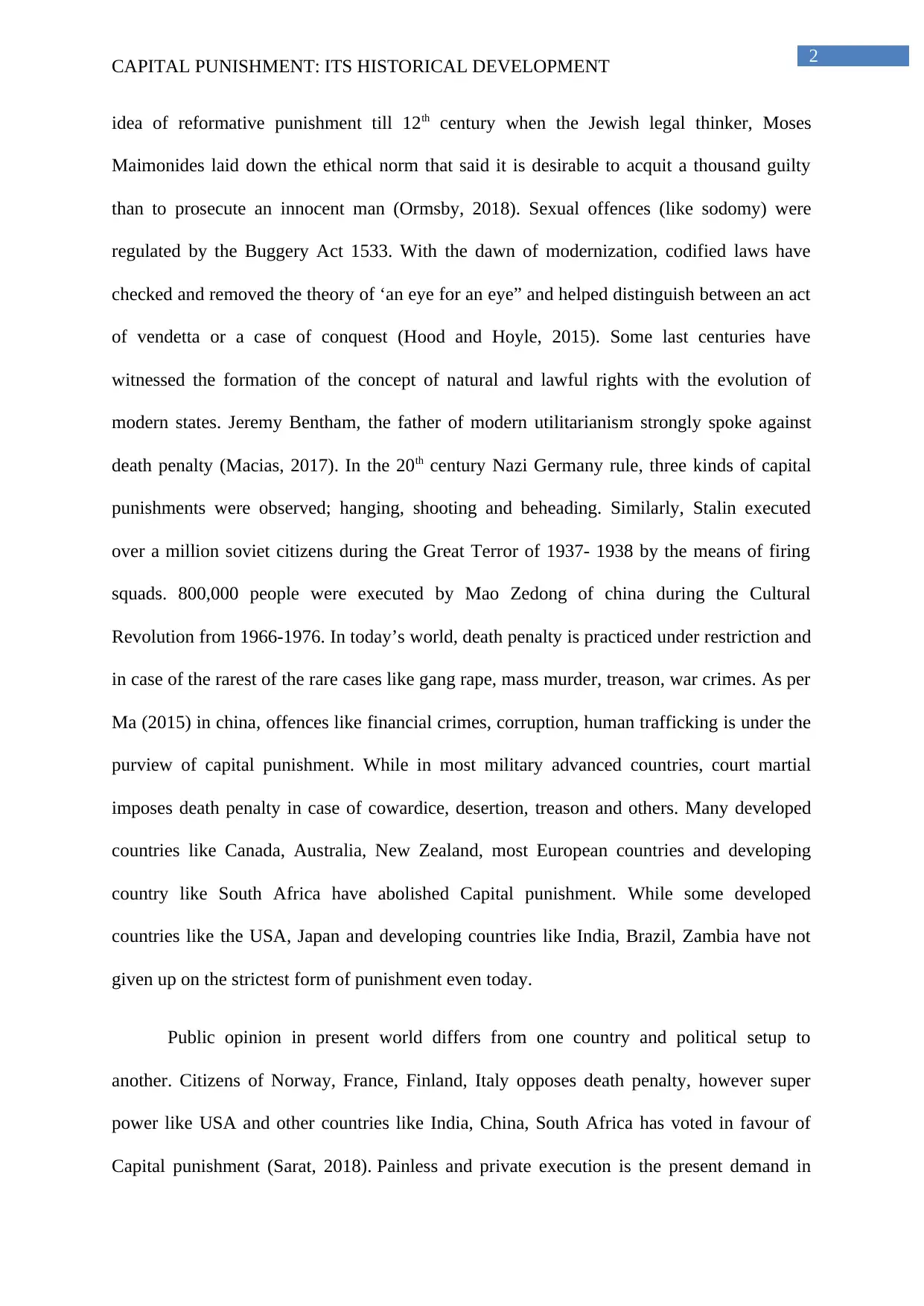
2
CAPITAL PUNISHMENT: ITS HISTORICAL DEVELOPMENT
idea of reformative punishment till 12th century when the Jewish legal thinker, Moses
Maimonides laid down the ethical norm that said it is desirable to acquit a thousand guilty
than to prosecute an innocent man (Ormsby, 2018). Sexual offences (like sodomy) were
regulated by the Buggery Act 1533. With the dawn of modernization, codified laws have
checked and removed the theory of ‘an eye for an eye” and helped distinguish between an act
of vendetta or a case of conquest (Hood and Hoyle, 2015). Some last centuries have
witnessed the formation of the concept of natural and lawful rights with the evolution of
modern states. Jeremy Bentham, the father of modern utilitarianism strongly spoke against
death penalty (Macias, 2017). In the 20th century Nazi Germany rule, three kinds of capital
punishments were observed; hanging, shooting and beheading. Similarly, Stalin executed
over a million soviet citizens during the Great Terror of 1937- 1938 by the means of firing
squads. 800,000 people were executed by Mao Zedong of china during the Cultural
Revolution from 1966-1976. In today’s world, death penalty is practiced under restriction and
in case of the rarest of the rare cases like gang rape, mass murder, treason, war crimes. As per
Ma (2015) in china, offences like financial crimes, corruption, human trafficking is under the
purview of capital punishment. While in most military advanced countries, court martial
imposes death penalty in case of cowardice, desertion, treason and others. Many developed
countries like Canada, Australia, New Zealand, most European countries and developing
country like South Africa have abolished Capital punishment. While some developed
countries like the USA, Japan and developing countries like India, Brazil, Zambia have not
given up on the strictest form of punishment even today.
Public opinion in present world differs from one country and political setup to
another. Citizens of Norway, France, Finland, Italy opposes death penalty, however super
power like USA and other countries like India, China, South Africa has voted in favour of
Capital punishment (Sarat, 2018). Painless and private execution is the present demand in
CAPITAL PUNISHMENT: ITS HISTORICAL DEVELOPMENT
idea of reformative punishment till 12th century when the Jewish legal thinker, Moses
Maimonides laid down the ethical norm that said it is desirable to acquit a thousand guilty
than to prosecute an innocent man (Ormsby, 2018). Sexual offences (like sodomy) were
regulated by the Buggery Act 1533. With the dawn of modernization, codified laws have
checked and removed the theory of ‘an eye for an eye” and helped distinguish between an act
of vendetta or a case of conquest (Hood and Hoyle, 2015). Some last centuries have
witnessed the formation of the concept of natural and lawful rights with the evolution of
modern states. Jeremy Bentham, the father of modern utilitarianism strongly spoke against
death penalty (Macias, 2017). In the 20th century Nazi Germany rule, three kinds of capital
punishments were observed; hanging, shooting and beheading. Similarly, Stalin executed
over a million soviet citizens during the Great Terror of 1937- 1938 by the means of firing
squads. 800,000 people were executed by Mao Zedong of china during the Cultural
Revolution from 1966-1976. In today’s world, death penalty is practiced under restriction and
in case of the rarest of the rare cases like gang rape, mass murder, treason, war crimes. As per
Ma (2015) in china, offences like financial crimes, corruption, human trafficking is under the
purview of capital punishment. While in most military advanced countries, court martial
imposes death penalty in case of cowardice, desertion, treason and others. Many developed
countries like Canada, Australia, New Zealand, most European countries and developing
country like South Africa have abolished Capital punishment. While some developed
countries like the USA, Japan and developing countries like India, Brazil, Zambia have not
given up on the strictest form of punishment even today.
Public opinion in present world differs from one country and political setup to
another. Citizens of Norway, France, Finland, Italy opposes death penalty, however super
power like USA and other countries like India, China, South Africa has voted in favour of
Capital punishment (Sarat, 2018). Painless and private execution is the present demand in
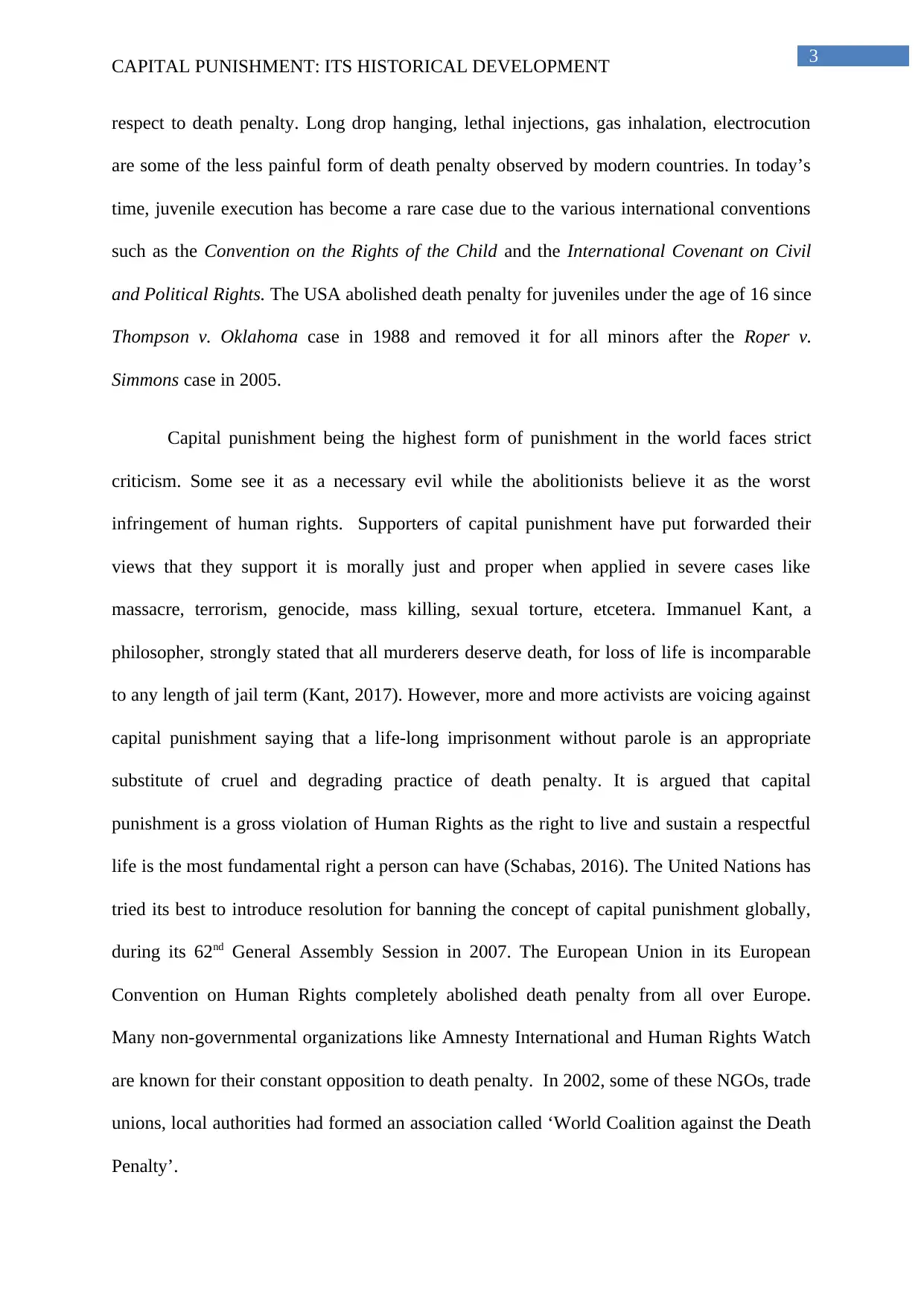
3
CAPITAL PUNISHMENT: ITS HISTORICAL DEVELOPMENT
respect to death penalty. Long drop hanging, lethal injections, gas inhalation, electrocution
are some of the less painful form of death penalty observed by modern countries. In today’s
time, juvenile execution has become a rare case due to the various international conventions
such as the Convention on the Rights of the Child and the International Covenant on Civil
and Political Rights. The USA abolished death penalty for juveniles under the age of 16 since
Thompson v. Oklahoma case in 1988 and removed it for all minors after the Roper v.
Simmons case in 2005.
Capital punishment being the highest form of punishment in the world faces strict
criticism. Some see it as a necessary evil while the abolitionists believe it as the worst
infringement of human rights. Supporters of capital punishment have put forwarded their
views that they support it is morally just and proper when applied in severe cases like
massacre, terrorism, genocide, mass killing, sexual torture, etcetera. Immanuel Kant, a
philosopher, strongly stated that all murderers deserve death, for loss of life is incomparable
to any length of jail term (Kant, 2017). However, more and more activists are voicing against
capital punishment saying that a life-long imprisonment without parole is an appropriate
substitute of cruel and degrading practice of death penalty. It is argued that capital
punishment is a gross violation of Human Rights as the right to live and sustain a respectful
life is the most fundamental right a person can have (Schabas, 2016). The United Nations has
tried its best to introduce resolution for banning the concept of capital punishment globally,
during its 62nd General Assembly Session in 2007. The European Union in its European
Convention on Human Rights completely abolished death penalty from all over Europe.
Many non-governmental organizations like Amnesty International and Human Rights Watch
are known for their constant opposition to death penalty. In 2002, some of these NGOs, trade
unions, local authorities had formed an association called ‘World Coalition against the Death
Penalty’.
CAPITAL PUNISHMENT: ITS HISTORICAL DEVELOPMENT
respect to death penalty. Long drop hanging, lethal injections, gas inhalation, electrocution
are some of the less painful form of death penalty observed by modern countries. In today’s
time, juvenile execution has become a rare case due to the various international conventions
such as the Convention on the Rights of the Child and the International Covenant on Civil
and Political Rights. The USA abolished death penalty for juveniles under the age of 16 since
Thompson v. Oklahoma case in 1988 and removed it for all minors after the Roper v.
Simmons case in 2005.
Capital punishment being the highest form of punishment in the world faces strict
criticism. Some see it as a necessary evil while the abolitionists believe it as the worst
infringement of human rights. Supporters of capital punishment have put forwarded their
views that they support it is morally just and proper when applied in severe cases like
massacre, terrorism, genocide, mass killing, sexual torture, etcetera. Immanuel Kant, a
philosopher, strongly stated that all murderers deserve death, for loss of life is incomparable
to any length of jail term (Kant, 2017). However, more and more activists are voicing against
capital punishment saying that a life-long imprisonment without parole is an appropriate
substitute of cruel and degrading practice of death penalty. It is argued that capital
punishment is a gross violation of Human Rights as the right to live and sustain a respectful
life is the most fundamental right a person can have (Schabas, 2016). The United Nations has
tried its best to introduce resolution for banning the concept of capital punishment globally,
during its 62nd General Assembly Session in 2007. The European Union in its European
Convention on Human Rights completely abolished death penalty from all over Europe.
Many non-governmental organizations like Amnesty International and Human Rights Watch
are known for their constant opposition to death penalty. In 2002, some of these NGOs, trade
unions, local authorities had formed an association called ‘World Coalition against the Death
Penalty’.
Secure Best Marks with AI Grader
Need help grading? Try our AI Grader for instant feedback on your assignments.
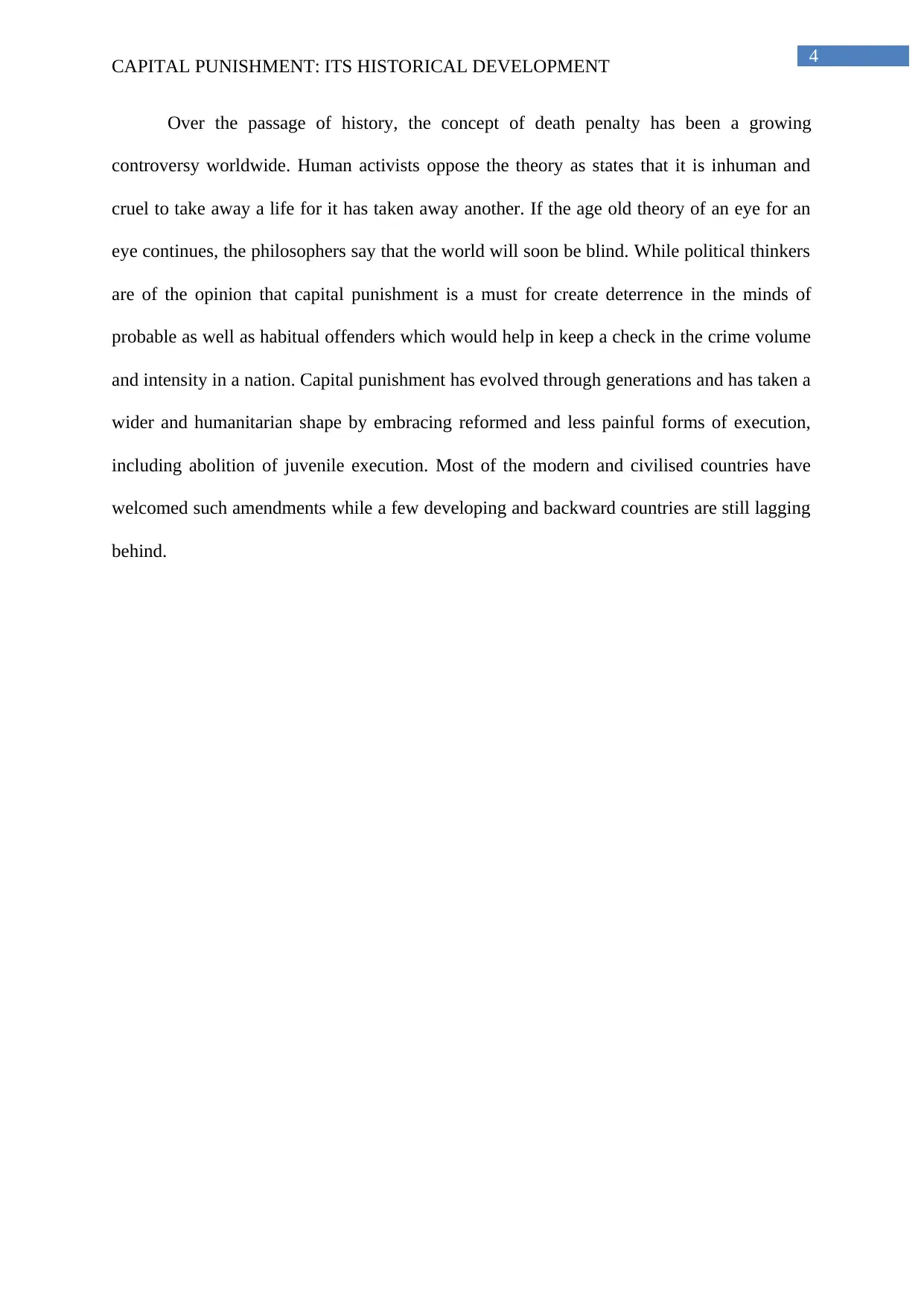
4
CAPITAL PUNISHMENT: ITS HISTORICAL DEVELOPMENT
Over the passage of history, the concept of death penalty has been a growing
controversy worldwide. Human activists oppose the theory as states that it is inhuman and
cruel to take away a life for it has taken away another. If the age old theory of an eye for an
eye continues, the philosophers say that the world will soon be blind. While political thinkers
are of the opinion that capital punishment is a must for create deterrence in the minds of
probable as well as habitual offenders which would help in keep a check in the crime volume
and intensity in a nation. Capital punishment has evolved through generations and has taken a
wider and humanitarian shape by embracing reformed and less painful forms of execution,
including abolition of juvenile execution. Most of the modern and civilised countries have
welcomed such amendments while a few developing and backward countries are still lagging
behind.
CAPITAL PUNISHMENT: ITS HISTORICAL DEVELOPMENT
Over the passage of history, the concept of death penalty has been a growing
controversy worldwide. Human activists oppose the theory as states that it is inhuman and
cruel to take away a life for it has taken away another. If the age old theory of an eye for an
eye continues, the philosophers say that the world will soon be blind. While political thinkers
are of the opinion that capital punishment is a must for create deterrence in the minds of
probable as well as habitual offenders which would help in keep a check in the crime volume
and intensity in a nation. Capital punishment has evolved through generations and has taken a
wider and humanitarian shape by embracing reformed and less painful forms of execution,
including abolition of juvenile execution. Most of the modern and civilised countries have
welcomed such amendments while a few developing and backward countries are still lagging
behind.
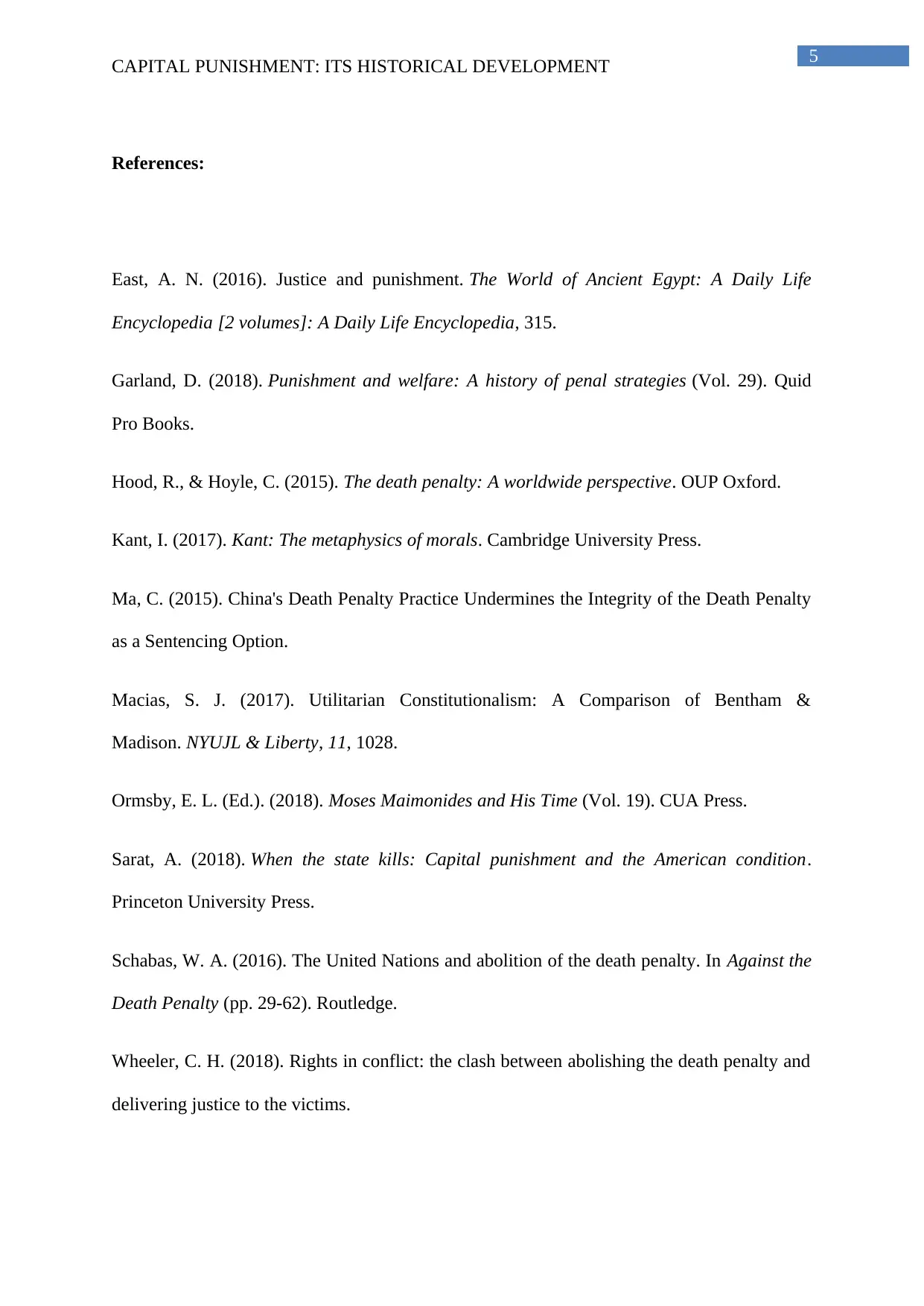
5
CAPITAL PUNISHMENT: ITS HISTORICAL DEVELOPMENT
References:
East, A. N. (2016). Justice and punishment. The World of Ancient Egypt: A Daily Life
Encyclopedia [2 volumes]: A Daily Life Encyclopedia, 315.
Garland, D. (2018). Punishment and welfare: A history of penal strategies (Vol. 29). Quid
Pro Books.
Hood, R., & Hoyle, C. (2015). The death penalty: A worldwide perspective. OUP Oxford.
Kant, I. (2017). Kant: The metaphysics of morals. Cambridge University Press.
Ma, C. (2015). China's Death Penalty Practice Undermines the Integrity of the Death Penalty
as a Sentencing Option.
Macias, S. J. (2017). Utilitarian Constitutionalism: A Comparison of Bentham &
Madison. NYUJL & Liberty, 11, 1028.
Ormsby, E. L. (Ed.). (2018). Moses Maimonides and His Time (Vol. 19). CUA Press.
Sarat, A. (2018). When the state kills: Capital punishment and the American condition.
Princeton University Press.
Schabas, W. A. (2016). The United Nations and abolition of the death penalty. In Against the
Death Penalty (pp. 29-62). Routledge.
Wheeler, C. H. (2018). Rights in conflict: the clash between abolishing the death penalty and
delivering justice to the victims.
CAPITAL PUNISHMENT: ITS HISTORICAL DEVELOPMENT
References:
East, A. N. (2016). Justice and punishment. The World of Ancient Egypt: A Daily Life
Encyclopedia [2 volumes]: A Daily Life Encyclopedia, 315.
Garland, D. (2018). Punishment and welfare: A history of penal strategies (Vol. 29). Quid
Pro Books.
Hood, R., & Hoyle, C. (2015). The death penalty: A worldwide perspective. OUP Oxford.
Kant, I. (2017). Kant: The metaphysics of morals. Cambridge University Press.
Ma, C. (2015). China's Death Penalty Practice Undermines the Integrity of the Death Penalty
as a Sentencing Option.
Macias, S. J. (2017). Utilitarian Constitutionalism: A Comparison of Bentham &
Madison. NYUJL & Liberty, 11, 1028.
Ormsby, E. L. (Ed.). (2018). Moses Maimonides and His Time (Vol. 19). CUA Press.
Sarat, A. (2018). When the state kills: Capital punishment and the American condition.
Princeton University Press.
Schabas, W. A. (2016). The United Nations and abolition of the death penalty. In Against the
Death Penalty (pp. 29-62). Routledge.
Wheeler, C. H. (2018). Rights in conflict: the clash between abolishing the death penalty and
delivering justice to the victims.
1 out of 6
Related Documents
Your All-in-One AI-Powered Toolkit for Academic Success.
+13062052269
info@desklib.com
Available 24*7 on WhatsApp / Email
![[object Object]](/_next/static/media/star-bottom.7253800d.svg)
Unlock your academic potential
© 2024 | Zucol Services PVT LTD | All rights reserved.




